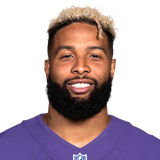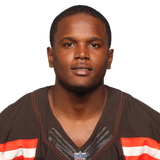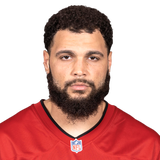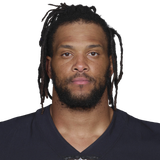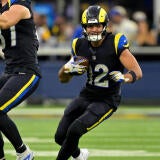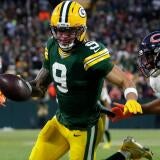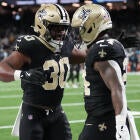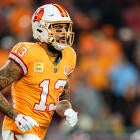2019 Fantasy Football Draft Prep: Air yards provide clues to the Browns and Bucs passing games
The Browns and Bucs have seen some turnover in their passing games this offseason. Ben Gretch shows how air yards can help us sort out the roles for 2019.
The Browns and Bucs are two offenses that should feature vertical passing games in 2019. The Bucs have led the NFL in air yards each of the past two seasons, finishing with about 20% more than any other team over that span. The Browns come in second on that list, and this offseason they brought over Tampa Bay offensive coordinator Todd Monken.
But losing Monken and former head coach Dirk Koetter doesn't mean the Bucs will suddenly change course. This offseason, Tampa brought in the man perhaps best suited to maintain Tampa's offensive style, Bruce Arians. His Cardinals offense led the league in air yards in 2016 and was second to the Bucs in 2017, his final year in the desert. And wouldn't you know it? New Browns head coach Freddie Kitchens was on Arians' staff in Arizona through 2017, before heading to Cleveland in the 2018 offseason.
So both teams have a recent history with vertical passing games and are again staffed with coaches whose histories align with that mentality. There are a lot of similarities here, and they are all good for Fantasy because vertical passing games typically generate more yards on a per-attempt basis, and also typically send a high percentage of those yards to wide receivers and tight ends.
Air yards data can help us break down where those targets might go, and at what depths, giving us a good picture of who to target. If you're not sure what air yards are or need a little refresher on how to use them, I recently wrote an air yards primer to help get you up to speed.
Let's walk through how I projected these two offenses using air yards.
Cleveland Browns
Cleveland will likely be better this year, which could lead to a higher rush percentage, but when they throw, this will almost certainly be one of the league's most vertical passing games. That's a major reason, on top of the addition of Odell Beckham, that there's so much hype around them.
So what does that mean for their receiving corps? Beckham will likely take over the No. 1 role, and while I understand the apprehension about a relatively even target split in Cleveland late last year, I typically operate from the assumption that true alpha receivers get theirs and then everyone else competes for what's left. He's my WR3 in PPR formats, WR2 in non-PPR.
| ||||||||||||
The man who occupied that No. 1 role last year, Jarvis Landry, didn't find much success in it. He also experienced a substantially different air yards profile from his four years in Miami. Landry totaled 570 targets over his time with the Dolphins, with an average depth of target (aDOT) coming in at just 6.6 (the league average WR target last year was 11.1 yards of depth).
These were short, high-efficiency throws, which typically mean a higher catch rate and more yards after the catch. Landry caught just over 70% of his targets in Miami.
Last season, Landry's aDOT was 11.9, and he had a catch rate of just 54.4% on these deeper passes. The easy expectation is for some of the downfield targets to shift over to Beckham, while Landry is free to run more of the underneath routes he once thrived on in Miami. If we look at Monken's Tampa Bay offense as a template, Beckham would occupy a role similar to that of Mike Evans, while Landry would be the Adam Humphries. Humphries posted the WR24 season in PPR last year in Tampa in part thanks to a 72% catch rate on 105 targets that came in at a 6.7 aDOT.
Landry has always been a high-target receiver, averaging 9.0 per game over his career and at least eight per game in each of his past four seasons. I currently have him projected for just 117 targets (7.3 per game), with a line eerily similar across the board to Humphries' 2018.
| ||||||||||||
Even at that volume -- and he likely has some upside beyond it -- Landry could be a steal in PPR leagues where he falls a bit on Draft Day. In his final three seasons in Miami, on more volume than I'm projecting, he finished as the PPR WR11, WR13 and WR4.
David Njoku's target depth is also of note. At 8.9 in 2018, Njoku's aDOT was more than a yard higher than league average for a tight end (7.6 aDOT), and that actually came down from the 10.6 Njoku posted in his rookie 2017 season. As an athletic stretch tight end, Njoku isn't as much of a concern for what I'm projecting as Landry's underneath role. O.J. Howard, for example, posted aDOTs of 12.4 and 11.8 the past two seasons in Tampa.
While Njoku may not see big target numbers, at that depth he has the potential to post a stronger yards per target than a typical tight end, much like Howard has over the past two seasons in Tampa.
| ||||||||||||
If we follow that Tampa Bay template even further, Antonio Callaway makes a lot of sense as the WR3. The second-year speedster hit some rookie bumps, but he profiles well as the DeSean Jackson-type deep threat. Jackson didn't have a great connection with Jameis Winston during his time in Tampa, but posted a huge start to 2018 with Ryan Fitzpatrick under center, averaging over 100 yards across four September games on just 5.5 targets per game. Callaway's 4.4 speed and 13.9 aDOT from 2018 indicate he could play a similar role.
| ||||||||||||
But the camp hype out of Cleveland has been favoring Rashard Higgins ahead of Callaway, making this a little more difficult to sort out. Higgins was a strong prospect with good age-adjusted production at Colorado State despite a limited athletic profile. He's more of a technician, and if he wins the larger share of the playing time at the second outside wide receiver spot, I'd still expect Callaway to play as a field-stretcher. That might limit both players' Fantasy outlooks, though both could have their moments, much like what we saw from Jackson and Chris Godwin last season.
| ||||||||||||
Tampa Bay Buccaneers
While I used the Bucs as a template for the Browns in many ways, the departures of Jackson and Humphries make the distribution of receiving opportunity in Tampa a bit more opaque.
| ||||||||||||
Evans will retain his role as the lead outside receiving option, and with four consecutive seasons of at least 135 targets at an aDOT at 14.0 or higher, we can be confident he'll get plenty of high-value targets.
But it's the offseason quotes about Chris Godwin playing more in the slot that are very interesting here. Though Arians' previous offenses featured plenty of downfield passing to players like John Brown, Jaron Brown, J.J. Nelson and Michael Floyd, it was Larry Fitzgerald in the slot who typically led the team in targets.
| ||||||||||||
Fitzgerald's aDOTs fell in this offense as he aged. After previously being at 10 or higher, Fitzgerald's aDOTs from 2015-2017 were between 7.7 and 8.8, and he caught 109, 107 and 109 balls in those three years, working primarily out of the slot. This adds some context to Arians' comparisons of Godwin and Fitzgerald, as well as what we should expect from Godwin while he takes over the slot role Humphries vacated.
Godwin's aDOT was at 13.2 in his rookie season, then 11.9 last year. I don't expect his aDOT to suddenly be in the Fitzgerald range (or lower, like Humphries), but I do have it falling to 10.5. The tradeoff of more short passes is a potential boost in target rate and a higher catch rate, and that's where the much-discussed 100-catch quote from Arians comes into play. In my latest round of projections, I have Godwin at career highs for targets and catch rate, with 87 catches overall.
| ||||||||||||
I talked about Howard's role above, and despite some concern about Arians' relative lack of utilization of the tight end position in prior offenses, he's never had a tight end anywhere near this caliber. Howard's efficiency metrics through two seasons make even Rob Gronkowski's look subpar by comparison. It's a long shot Howard will eventually become the greatest receiving tight end ever -- meaning his efficiency needs to regress -- but he has the prospect pedigree, the draft pedigree and the early-career production to make that something you can discuss with a straight face.
Before Gronkowski emerged (along with Aaron Hernandez) for New England, the Patriots didn't use their tight ends much, either. These things evolve, and Howard is clearly a top-three option in this passing offense. I've brought his aDOT and efficiency down a bit, but still have him projected for the highest yards per target among all tight ends. If he beats this volume projection and maintains that type of downfield profile, he could challenge for TE1.
Outside that trio, I have Cameron Brate seeing about 40 targets, and there's still a significant downfield role for an outside receiver, but it's difficult to know where to assign it. For now, I've given Breshad Perriman a decent share, but youngsters Justin Watson and Scott Miller both have the speed to fit in a similar role. I'm currently thinking of this role as a rotating one, much like we used to see from Arians' offenses in Arizona.
Final thoughts
It's always important to find ways to improve your process. In the above examples, I tried to show how incorporating air yards adds context to both the traditional opportunity metric we use for pass-catchers -- targets -- and also the efficiency metrics that play a big role in determining which players are Fantasy-viable and especially those who can become Fantasy stars.

